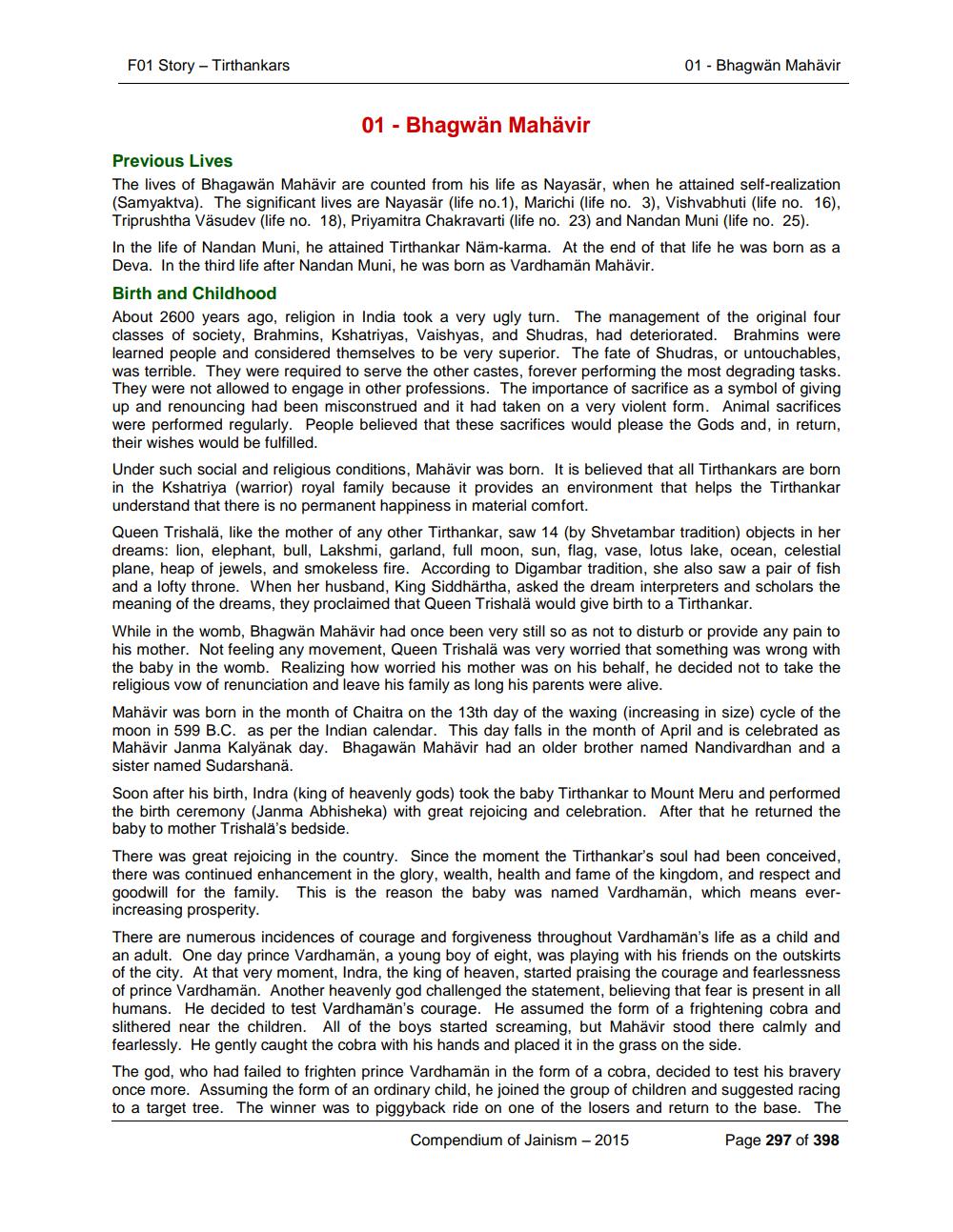________________
F01 Story Tirthankars
01 Bhagwan Mahävir
01 Bhagwan Mahävir
Previous Lives
The lives of Bhagawan Mahavir are counted from his life as Nayasär, when he attained self-realization (Samyaktva). The significant lives are Nayasär (life no.1), Marichi (life no. 3), Vishvabhuti (life no. 16), Triprushtha Väsudev (life no. 18), Priyamitra Chakravarti (life no. 23) and Nandan Muni (life no. 25).
In the life of Nandan Muni, he attained Tirthankar Näm-karma. At the end of that life he was born as a Deva. In the third life after Nandan Muni, he was born as Vardhamän Mahävir.
Birth and Childhood
About 2600 years ago, religion in India took a very ugly turn. The management of the original four classes of society, Brahmins, Kshatriyas, Vaishyas, and Shudras, had deteriorated. Brahmins were learned people and considered themselves to be very superior. The fate of Shudras, or untouchables, was terrible. They were required to serve the other castes, forever performing the most degrading tasks. They were not allowed to engage in other professions. The importance of sacrifice as a symbol of giving up and renouncing had been misconstrued and it had taken on a very violent form. Animal sacrifices were performed regularly. People believed that these sacrifices would please the Gods and, in return, their wishes would be fulfilled.
Under such social and religious conditions, Mahävir was born. It is believed that all Tirthankars are born in the Kshatriya (warrior) royal family because it provides an environment that helps the Tirthankar understand that there is no permanent happiness in material comfort.
Queen Trishalä, like the mother of any other Tirthankar, saw 14 (by Shvetambar tradition) objects in her dreams: lion, elephant, bull, Lakshmi, garland, full moon, sun, flag, vase, lotus lake, ocean, celestial plane, heap of jewels, and smokeless fire. According to Digambar tradition, she also saw a pair of fish and a lofty throne. When her husband, King Siddhärtha, asked the dream interpreters and scholars the meaning of the dreams, they proclaimed that Queen Trishalä would give birth to a Tirthankar.
While in the womb, Bhagwan Mahavir had once been very still so as not to disturb or provide any pain to his mother. Not feeling any movement, Queen Trishalä was very worried that something was wrong with the baby in the womb. Realizing how worried his mother was on his behalf, he decided not to take the religious vow of renunciation and leave his family as long his parents were alive.
Mahävir was born in the month of Chaitra on the 13th day of the waxing (increasing in size) cycle of the moon in 599 B.C. as per the Indian calendar. This day falls in the month of April and is celebrated as Mahavir Janma Kalyanak day. Bhagawan Mahavir had an older brother named Nandivardhan and a sister named Sudarshanä.
Soon after his birth, Indra (king of heavenly gods) took the baby Tirthankar to Mount Meru and performed the birth ceremony (Janma Abhisheka) with great rejoicing and celebration. After that he returned the baby to mother Trishalä's bedside.
There was great rejoicing in the country. Since the moment the Tirthankar's soul had been conceived, there was continued enhancement in the glory, wealth, health and fame of the kingdom, and respect and goodwill for the family. This is the reason the baby was named Vardhamän, which means everincreasing prosperity.
There are numerous incidences of courage and forgiveness throughout Vardhamän's life as a child and an adult. One day prince Vardhamän, a young boy of eight, was playing with his friends on the outskirts of the city. At that very moment, Indra, the king of heaven, started praising the courage and fearlessness of prince Vardhamän. Another heavenly god challenged the statement, believing that fear is present in all humans. He decided to test Vardhamän's courage. He assumed the form of a frightening cobra and slithered near the children. All of the boys started screaming, but Mahävir stood there calmly and fearlessly. He gently caught the cobra with his hands and placed it in the grass on the side.
The god, who had failed to frighten prince Vardhamän in the form of a cobra, decided to test his bravery once more. Assuming the form of an ordinary child, he joined the group of children and suggested racing to a target tree. The winner was to piggyback ride on one of the losers and return to the base. The
Compendium of Jainism - 2015
Page 297 of 398




